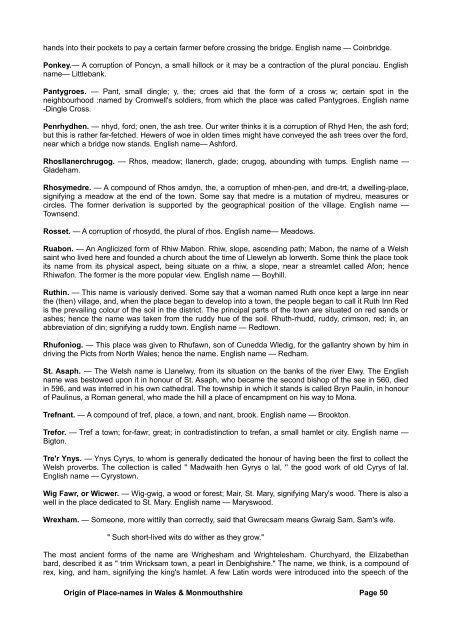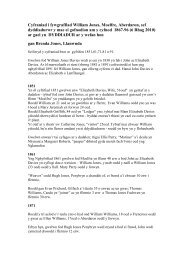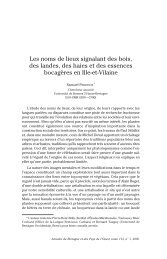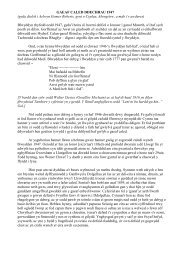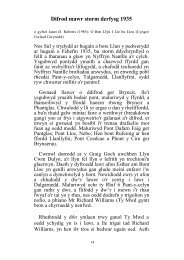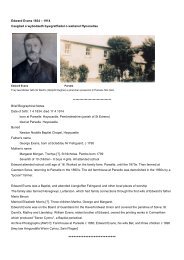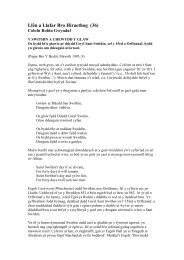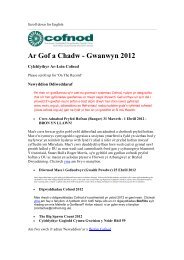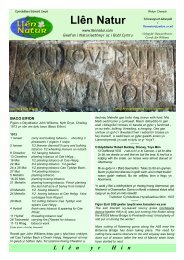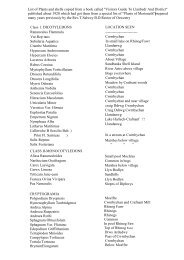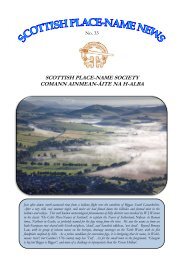Llanferres. — The church was probably dedicated, about <strong>the</strong> latter end <strong>of</strong> <strong>the</strong> fourth century, to Berres, adisciple <strong>of</strong> St. Mart<strong>in</strong>, <strong>the</strong> Hungarian. Dr. John Davies, <strong>the</strong> em<strong>in</strong>ent antiquarian, <strong>and</strong> <strong>the</strong> author <strong>of</strong> <strong>the</strong> Welsh-Lat<strong>in</strong> Dictionary, was a native <strong>of</strong> this, parish. English name — Berreston.Llangwm. — The name signifies a church <strong>in</strong> <strong>the</strong> vale or d<strong>in</strong>gle. English name — Churchcombe.Ll<strong>and</strong>doged. — The church was dedicated to Doged, a descendant <strong>of</strong> Cunedda, <strong>and</strong> a sa<strong>in</strong>t <strong>of</strong> <strong>the</strong> sixthcentury. " Bonedd y Sa<strong>in</strong>t " calls him Doged <strong>the</strong> K<strong>in</strong>g. English name — Shareton.Llanefydd. — Nefydd, a descendant <strong>of</strong> Brychan,. <strong>and</strong> a sa<strong>in</strong>t <strong>of</strong> <strong>the</strong> fifth century, founded <strong>the</strong> church. Englishname — Shipton.Llansannan. — Senally or Senanus, was a sa<strong>in</strong>t <strong>and</strong> an Irish bishop <strong>of</strong> <strong>the</strong> sixth century, <strong>and</strong> it is calculatedthat he lived <strong>in</strong> Wales from <strong>the</strong> fact that this church was dedicated to him. English name — Senanton.Llanfair-Talhaiarn. — The church is dedicated to St. Mary. Talhaiarn was a celebrated bard <strong>and</strong> sa<strong>in</strong>t <strong>of</strong> <strong>the</strong>sixth century. He was also a chapla<strong>in</strong> to Emrys Wledig; but after <strong>the</strong> latter was killed, he became a hermit,<strong>and</strong> founded <strong>the</strong> church which bears his name. English name — Talhaiarn, or Ironfront.Llanarmon-yn-Ial. — The church was dedicated to St. Garmon, bishop <strong>of</strong> Auxerre. Ial, <strong>the</strong> name <strong>of</strong> <strong>the</strong>cantrev, means an open space or region. Tir ial, open l<strong>and</strong>. Yale, Derbyshire, is derived from <strong>the</strong> same root.Ial is <strong>the</strong> differentia added to dist<strong>in</strong>guish <strong>the</strong> <strong>place</strong> from <strong>the</strong> o<strong>the</strong>r Llanarmon. The " Topographical Dictionary<strong>of</strong> Wales " says that " with<strong>in</strong> a niche <strong>in</strong> <strong>the</strong> outer wall <strong>of</strong> <strong>the</strong> church is <strong>the</strong> figure <strong>of</strong> a bishop, six feet four<strong>in</strong>ches <strong>in</strong> height, which is said to be that <strong>of</strong> St. Germanus, Bishop <strong>of</strong> Auxerre, who, with St. Lupus, .ga<strong>in</strong>edover <strong>the</strong> Picts <strong>and</strong> Saxons, at Maesgarmon, near Mold, <strong>in</strong> <strong>the</strong> year 420, <strong>the</strong> celebrated victory called byhistorians Victoria Alleluiatica. M English name — Garmonton.Llanarmon Dyffryn Ceiriog. — The village is situated on <strong>the</strong> river Ceiriog; hence <strong>the</strong> differentia. The parishis supposed to have been <strong>the</strong> burial-<strong>place</strong> <strong>of</strong> St. Germanus. English name — Garmonham.Moelfre. — Moel, bare, bald; fre-fryn, hill. English name — Baldhill.M<strong>in</strong>era. — The primitive name <strong>of</strong> this <strong>place</strong> was Mwyn-y-Clawdd, <strong>the</strong> m<strong>in</strong>e-ditch, <strong>in</strong> allusion to Offa's Dyke,which passes through it; <strong>and</strong> <strong>the</strong> present name is probably derived from <strong>the</strong> abundance <strong>of</strong> m<strong>in</strong>erals itconta<strong>in</strong>s. English name — M<strong>in</strong>eham.Mochdre. — Mock, quick, swift; or, perhaps, it is <strong>the</strong> plural for pigs; dre-tref, a dwell<strong>in</strong>g-<strong>place</strong>. English name— Sw<strong>in</strong>eham.Marchwiail. — March, perhaps, is <strong>the</strong> same as mare, a mark, <strong>and</strong> wiail is <strong>the</strong> plural <strong>of</strong> gwialen, a rod.View<strong>in</strong>g <strong>the</strong> geographical position <strong>of</strong> this <strong>place</strong>, be<strong>in</strong>g <strong>in</strong> close proximity to Wat's Dyke, we are <strong>of</strong> op<strong>in</strong>ion that<strong>the</strong> l<strong>in</strong>e <strong>of</strong> demarcation was made <strong>of</strong> rods or poles ; hence <strong>the</strong> <strong>orig<strong>in</strong></strong> <strong>of</strong> <strong>the</strong> name. English name — Markton.Moss. — A corruption, perhaps, <strong>of</strong> ffos, a ditch or trench. Ffos is cognate with <strong>the</strong> Lat<strong>in</strong> fossa, a ditch. Mossis <strong>the</strong> Norse for bog. English name — Bogton.Nantglyn. — Nant, brook; glyn, glen, vale. English name — Brookvale.Oernant. — Oer, cold; nant, brook. English name — Coldbrook.Penrhos. — A compound <strong>of</strong> pen, head, end; ai rhos, a meadow, a moor. English name — Moorsend.Pensarn. — The name signifies <strong>the</strong> end <strong>of</strong> <strong>the</strong> Roman road. Castell-y-cawr, <strong>the</strong> giant's castle, which isconsidered to be one <strong>of</strong> <strong>the</strong> most complete Roman camps <strong>in</strong> <strong>the</strong> k<strong>in</strong>gdom, is <strong>in</strong> this vic<strong>in</strong>ity. English name—Viaton.Pentrefoelas. — Pentre, village; moel, a pile, conical hill; las-glas, blue. Many <strong>of</strong> our mounta<strong>in</strong>s <strong>and</strong> hillsbear <strong>the</strong> name moel, such as Moel Siabo Y Foel (Cwmavon), Moelyfamau, Moelwyn, Y Fc Goch, <strong>and</strong> <strong>the</strong>Foel Las. English name — Hillham.Pontllogell. — Pont, bridge; llogell, pocket, called, probably, from <strong>the</strong> pedestrians be<strong>in</strong>g obliged put <strong>the</strong>irOrig<strong>in</strong> <strong>of</strong> Place-<strong>names</strong> <strong>in</strong> Wales & Monmouthshire Page 49
h<strong>and</strong>s <strong>in</strong>to <strong>the</strong>ir pockets to pay a certa<strong>in</strong> farmer before cross<strong>in</strong>g <strong>the</strong> bridge. English name — Co<strong>in</strong>bridge.Ponkey.— A corruption <strong>of</strong> Poncyn, a small hillock or it may be a contraction <strong>of</strong> <strong>the</strong> plural ponciau. Englishname— Littlebank.Pantygroes. — Pant, small d<strong>in</strong>gle; y, <strong>the</strong>; croes aid that <strong>the</strong> form <strong>of</strong> a cross w; certa<strong>in</strong> spot <strong>in</strong> <strong>the</strong>neighbourhood :named by Cromwell's soldiers, from which <strong>the</strong> <strong>place</strong> was called Pantygroes. English name-D<strong>in</strong>gle Cross.Penrhydhen. — nhyd, ford; onen, <strong>the</strong> ash tree. Our writer th<strong>in</strong>ks it is a corruption <strong>of</strong> Rhyd Hen, <strong>the</strong> ash ford;but this is ra<strong>the</strong>r far-fetched. Hewers <strong>of</strong> woe <strong>in</strong> olden times might have conveyed <strong>the</strong> ash trees over <strong>the</strong> ford,near which a bridge now st<strong>and</strong>s. English name— Ashford.Rhosllanerchrugog. — Rhos, meadow; llanerch, glade; crugog, abound<strong>in</strong>g with tumps. English name —Gladeham.Rhosymedre. — A compound <strong>of</strong> Rhos amdyn, <strong>the</strong>, a corruption <strong>of</strong> mhen-pen, <strong>and</strong> dre-trt, a dwell<strong>in</strong>g-<strong>place</strong>,signify<strong>in</strong>g a meadow at <strong>the</strong> end <strong>of</strong> <strong>the</strong> town. Some say that medre is a mutation <strong>of</strong> mydreu, measures orcircles. The former derivation is supported by <strong>the</strong> geographical position <strong>of</strong> <strong>the</strong> village. English name —Townsend.Rosset. — A corruption <strong>of</strong> rhosydd, <strong>the</strong> plural <strong>of</strong> rhos. English name— Meadows.Ruabon. — An Anglicized form <strong>of</strong> Rhiw Mabon. Rhiw, slope, ascend<strong>in</strong>g path; Mabon, <strong>the</strong> name <strong>of</strong> a Welshsa<strong>in</strong>t who lived here <strong>and</strong> founded a church about <strong>the</strong> time <strong>of</strong> Llewelyn ab Iorwerth. Some th<strong>in</strong>k <strong>the</strong> <strong>place</strong> tookits name from its physical aspect, be<strong>in</strong>g situate on a rhiw, a slope, near a streamlet called Afon; henceRhiwafon. The former is <strong>the</strong> more popular view. English name — Boyhill.Ruth<strong>in</strong>. — This name is variously derived. Some say that a woman named Ruth once kept a large <strong>in</strong>n near<strong>the</strong> (<strong>the</strong>n) village, <strong>and</strong>, when <strong>the</strong> <strong>place</strong> began to develop <strong>in</strong>to a town, <strong>the</strong> people began to call it Ruth Inn Redis <strong>the</strong> prevail<strong>in</strong>g colour <strong>of</strong> <strong>the</strong> soil <strong>in</strong> <strong>the</strong> district. The pr<strong>in</strong>cipal parts <strong>of</strong> <strong>the</strong> town are situated on red s<strong>and</strong>s orashes; hence <strong>the</strong> name was taken from <strong>the</strong> ruddy hue <strong>of</strong> <strong>the</strong> soil. Rhuth-rhudd, ruddy, crimson, red; <strong>in</strong>, anabbreviation <strong>of</strong> d<strong>in</strong>; signify<strong>in</strong>g a ruddy town. English name — Redtown.Rhufoniog. — This <strong>place</strong> was given to Rhufawn, son <strong>of</strong> Cunedda Wledig, for <strong>the</strong> gallantry shown by him <strong>in</strong>driv<strong>in</strong>g <strong>the</strong> Picts from North Wales; hence <strong>the</strong> name. English name — Redham.St. Asaph. — The Welsh name is Llanelwy, from its situation on <strong>the</strong> banks <strong>of</strong> <strong>the</strong> river Elwy. The Englishname was bestowed upon it <strong>in</strong> honour <strong>of</strong> St. Asaph, who became <strong>the</strong> second bishop <strong>of</strong> <strong>the</strong> see <strong>in</strong> 560, died<strong>in</strong> 596, <strong>and</strong> was <strong>in</strong>terred <strong>in</strong> his own ca<strong>the</strong>dral. The township <strong>in</strong> which it st<strong>and</strong>s is called Bryn Paul<strong>in</strong>, <strong>in</strong> honour<strong>of</strong> Paul<strong>in</strong>us, a Roman general, who made <strong>the</strong> hill a <strong>place</strong> <strong>of</strong> encampment on his way to Mona.Trefnant. — A compound <strong>of</strong> tref, <strong>place</strong>, a town, <strong>and</strong> nant, brook. English name — Brookton.Trefor. — Tref a town; for-fawr, great; <strong>in</strong> contradist<strong>in</strong>ction to trefan, a small hamlet or city. English name —Bigton.Tre'r Ynys. — Ynys Cyrys, to whom is generally dedicated <strong>the</strong> honour <strong>of</strong> hav<strong>in</strong>g been <strong>the</strong> first to collect <strong>the</strong>Welsh proverbs. The collection is called " Madwaith hen Gyrys o Ial, '' <strong>the</strong> good work <strong>of</strong> old Cyrys <strong>of</strong> Ial.English name — Cyrystown.Wig Fawr, or Wicwer. — Wig-gwig, a wood or forest; Mair, St. Mary, signify<strong>in</strong>g Mary's wood. There is also awell <strong>in</strong> <strong>the</strong> <strong>place</strong> dedicated to St. Mary. English name — Maryswood.Wrexham. — Someone, more wittily than correctly, said that Gwrecsam means Gwraig Sam, Sam's wife." Such short-lived wits do wi<strong>the</strong>r as <strong>the</strong>y grow."The most ancient forms <strong>of</strong> <strong>the</strong> name are Wrighesham <strong>and</strong> Wrightelesham. Churchyard, <strong>the</strong> Elizabethanbard, described it as " trim Wricksam town, a pearl <strong>in</strong> Denbighshire." The name, we th<strong>in</strong>k, is a compound <strong>of</strong>rex, k<strong>in</strong>g, <strong>and</strong> ham, signify<strong>in</strong>g <strong>the</strong> k<strong>in</strong>g's hamlet. A few Lat<strong>in</strong> words were <strong>in</strong>troduced <strong>in</strong>to <strong>the</strong> speech <strong>of</strong> <strong>the</strong>Orig<strong>in</strong> <strong>of</strong> Place-<strong>names</strong> <strong>in</strong> Wales & Monmouthshire Page 50
- Page 1 and 2: HANDBOOK OF THE ORIGIN OF PLACE-NAM
- Page 3 and 4: § § § § §The Author begs to st
- Page 5 and 6: pitiful cries of the railway offici
- Page 7 and 8: Bishop Percy says that "in England,
- Page 9 and 10: The city of Chester is still popula
- Page 11 and 12: There's Cumwhitton, Cumwhinton, Cum
- Page 13 and 14: Llwyn in its primary' sense means a
- Page 15 and 16: PLACE-NAMES IN WALES.Wales. — The
- Page 17 and 18: Church are generally dedicated to e
- Page 19 and 20: think he was a contemporary of St.
- Page 21 and 22: Rhosbeirio. — Rhos, a moor, a dry
- Page 23 and 24: of Brecknock," states that this vic
- Page 25 and 26: Cam cnwir ef Cwmdu,Cwm gwyn yw & n
- Page 27 and 28: Penderyn. — A corruption probably
- Page 29 and 30: Ardudwy. — Ar, upon or above; tud
- Page 31 and 32: to mark its pre-eminence over the o
- Page 33 and 34: Some think that eirw is a corruptio
- Page 35 and 36: present form — Caerfyrddin.Abergw
- Page 37 and 38: place of refuge; hence the name. En
- Page 39 and 40: Llansawyl. — The church was dedic
- Page 41 and 42: eject. The village took its name fr
- Page 43 and 44: house, and attempted to kill an inf
- Page 45 and 46: Gwydir. — Prima facie one may tak
- Page 47 and 48: Nefyn. — The church was probably
- Page 49 and 50: DENBIGHSHIRE.Anglicized form of Din
- Page 51: Llangollen. — From Collen, a sain
- Page 55 and 56: Cefn. — The name signifies a ridg
- Page 57 and 58: Maesgarmon. — Named in honour of
- Page 59 and 60: Abertridwr. — Tridwr, three water
- Page 61 and 62: it is said, was originally built by
- Page 63 and 64: Cwmllynfell. — Cwm, a narrow vale
- Page 65 and 66: Gwarycaeau. — Gwdr, the nape of t
- Page 67 and 68: means a cultivated region, a vale,
- Page 69 and 70: Penrhiwfer.- Pen, head, top; rhiw,
- Page 71 and 72: Port Talbot. — So called in 1835
- Page 73 and 74: Trealaw. — This appellation was g
- Page 75 and 76: Aberdyfi. — So called from its si
- Page 77 and 78: Llanddwywe. — From Dwywau, a desc
- Page 79 and 80: Crickhowell and some in the directi
- Page 81 and 82: Griffithstown. — This village was
- Page 83 and 84: and gwy, water. Treiddiod troth tna
- Page 85 and 86: derive Tintern from din, fortified
- Page 87 and 88: Caersws. — It appears that the Ro
- Page 89 and 90: English name — Ervylton.Llanymech
- Page 91 and 92: Angle. — Probably from the angle-
- Page 93 and 94: Gellyswick. — Another hybrid. Gel
- Page 95 and 96: that the two rivers in their flowin
- Page 97 and 98: ecame the bishop of the see, and wa
- Page 99 and 100: earth formerly stood on a summit on
- Page 101 and 102: Pilleth. — A corruption of pwll,
- Page 103 and 104:
Howells, Rev. J., Mountain AshHowel
- Page 105 and 106:
Williams, D., PenywernWilliams, Rev


